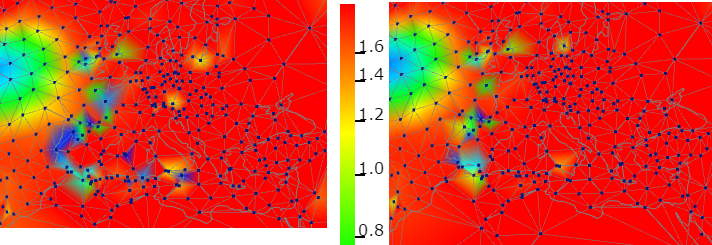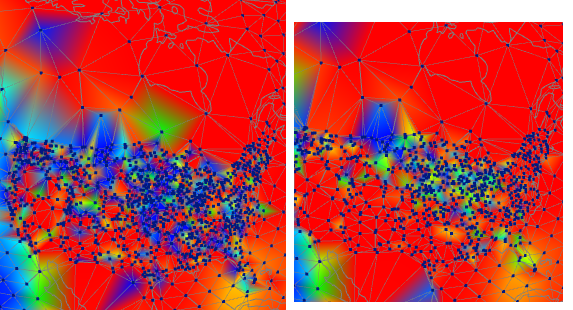There is a new Nature paper getting discussed in various places. It is called
Reconciling controversies about the 'global warming hiatus'. There is a
detailed discussion in the LA Times. The
Guardian chimes in. I got involved through a
WUWT post on a
GWPF paper. They seem to find support in it, but
other skeptics seem to think the reconciliation was effective, and are looking for the catch.
I thought it was a surprisingly political article for Nature, in that it traces how the hiatus gained prominence through pressure from contrarians and right wing politics, and scientists gradually came to take it seriously. I think they are right, but the process should be resisted. There really isn't much there, and the fact that contrarians create a hullabaloo doesn't mean that it is worth serious study. I'll show why I think that.
I'm going to show plots of various data since 2001, which is the period quoted (eg by GWPF) which excludes the 1998 El Nino. They weren't so scrupulous about that in the past, but now they want to exclude the recent warm years. Typically "hiatus" periods end about 2013. I recommend using the
temperature trend viewer to see this in perspective. The most hiatus-prone of the surface datasets, by far is HADCRUT (Cowtan and Way
explain why). Here is the Viewer picture of HADCRUT 4 trends in the period:

Each dot respresents a trend period, between the start year on the y-axis and the end on the x-axis. It's a lot easier to figure out in the viewer, which has an active time series graph which will show you when you click what is represented. If you cherry-pick well, you can find a 13-year period with zero slope, shown by the brown contour. And you'll see that the hiatus periods form two descending columns, headed by a blue blob. These are the periods which end in a fixed year (approx) on the x-axis - ie a dip. There are just two of them, and they are the La Nina years of 2008/9 and 2011/2. The location of those events determines the hiatus. If you look at other sets on the trend viewer, you'll see this much more weakly. At WUWT I listed the 2001-13 trends thus (error range converted to ±1σ):
| Dataset | Trend °C/cen |
| HADCRUT | 0.063 ± 0.301 |
| GISS | 0.506 ± 0.367 |
| NOAA | 0.509 ± 0.326 |
| BEST L/O | 0.468 ± 0.432 |
| C&Way | 0.489 ± 0.391 |
All except HADCRUT are quite positive. People sometimes speak of a slowdown. Incidentally, in the triangle plot, there is a reddish horizontal bar, bottom left, that is almost as prominent as the "pause". They are the strong positive trends that you can draw starting in 1999 - ie the 2001-6 warmth seen from the other end. I don't remember anyone getting excited about this feature.
I'd like to talk about the arithmetic of trends. Trend is a first central moment. It has a lot in common with moments of force, or torque. I think of it as a see-saw - a classic torque device. A heavyweight on the end has a lot of effect; in the middle not much. And of course, it depends which end. Trend is an odd see-saw, because it has both weights (cold periods) and uplifts (warm). It also has a progression. Items come on one end, and then progress across, exerting less and then opposite torque, until they drop off the other end (if you keep period fixed). So there isn't actually a lot of the period that is etermining the trend. It is predominantly the end forces.
I'll ilustrate that with this set of graphs (click the buttons below to see various datasets). It shows the mean (green) for 2001-2013 and colors the data (12-month running mean) as deviation from that value. The idea is that there has to be as much or more pulling the trend down rather than up, if it is to be negative. Either blue at the right or red at the left.
Now you can see that there aren't a lot of events that determine that. There is a red block from about 2001-6, which pulls the trend down. Then there are the two blue regions, the La Nina of 2008/9 and 2011/12, which also pull it down. The LN of 2008 has small torque on this period, but would have been effective earlier. @012 has the leverage, and so overcomes the sole uplift period or 2010.
That is just four periods, and it isn't hard to see how their effects can be chancy. It's really the 2001/6 warmth that is the anchor.
And then you see the big red period at the end, which overwhelms all this earlier stuff. GWPF and Co are keen to say that this is just a special case that should be excluded. Something like that it wasn't caused by CO2. But the 2001-6 period is also jus a natural excursion, and wasn't caused by CO2 either.
Basically the pause from 2001 won't come back until that big red is countered by a big blue. That would ensure that the trend returns close to that green line (extended). Of course, the red will be a powerful pauser for trends starting in 2015, and we'll hear about that soon enough.
Here is the same data colored by deviation from the trend from 2001 to present. We're still well on the red side of that too. The point here is that as long as new data lands above that line, it will be more red, and the trend will go up. It won't even reverse direction until you start seeing blue at that end. And if it did, there is a long way to go.
Now that the line has shifted, you can see how the blue periods would have destroyed such a trend earlier. But now, with their reduced leverage and the size of the red, that is where the trend ends up. For Hadcrut it's now 1.4°/Cen (other surface indices are higher).
So my conclusion is that, just as contrarians protest (with some justice) that not too much should be mad eof the current strong warming trends, because they are influenced by a single event, so too should the much waker hiatus be observed with modest interest, because it is the result of the concurrence of two weaker events, La Nina's, which get less noticed because they are less porminent, but are equally rather chance occurrences.





















